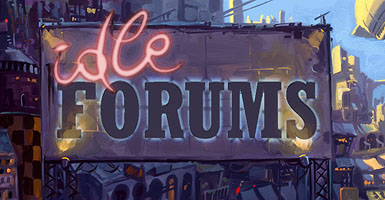Jonmad17
Members-
Content count
6 -
Joined
-
Last visited
About Jonmad17
-
Rank
Member
-

Idle Thumbs 228: New Game Plus or Minus World
Jonmad17 replied to Jake's topic in Idle Thumbs Episodes & Streams
I get the general impression that they ran out of time and money for chapter 2, so they just padded the game out with repeat missions. The title of the chapter is "race," but race and Western imperialism are much more prominent themes in the first chapter. It's like they had a longer game, realized that the scope was too ambitious, and just spent the little time they had left finishing the important cutscenes. -

Idle Thumbs 228: New Game Plus or Minus World
Jonmad17 replied to Jake's topic in Idle Thumbs Episodes & Streams
The game is structured in such an odd way. They're not original missions or presented as original missions, so repeating the story bits doesn't bother me. They're literally identical to previous missions but with prefixes that describe how they're different, [subsistence] meaning you find all of your weapons on site, [Extreme] meaning harder, etc. The weird thing is that they hide new story missions behind what should be optional content. So you have to play through harder versions of missions you already finished to see the new stuff. They really should have called Chapter 2 an epilogue and allowed you to do the new missions without those hurdles. It's a damn shame, because mission 43 and 46 are vital to the plot of the game, and most people won't see them because they already saw credits and won't bother replaying earlier stuff. -

Idle Thumbs 228: New Game Plus or Minus World
Jonmad17 replied to Jake's topic in Idle Thumbs Episodes & Streams
Big Boss really doesn't express an opinion regarding Quiet given that he's ostensibly a silent protagonist. The player is actually able to kill Quiet the first time they fight her, and the cinematics that trigger later on only unlock depending on your bond level with her. So the player is ultimately responsible for how they treat Quiet. And while there are some situations where the game forces you to look at her in a particular way, they make up about two cinematic in the entire game. You have the option to not recruit her, to not use her, and to not have her be part of your story. I don't see how she clashes with the idea of Big Boss being a player surrogate in any way. She actually exemplifies that idea more than any other character. -

Idle Thumbs 228: New Game Plus or Minus World
Jonmad17 replied to Jake's topic in Idle Thumbs Episodes & Streams
Chapter 2 works better if you think about it as an epilogue rather than a separate chapter. The threat is gone, the villain is dealt with. Chapter 2 is ostensibly an extended end sequence, with the few original missions actually being among the best in the game. Mission 43 in particular is spectacular from a narrative perspective. -

Idle Thumbs 228: New Game Plus or Minus World
Jonmad17 replied to Jake's topic in Idle Thumbs Episodes & Streams
I'm not going to sit here and defend her character design as if it wasn't just Japan being Japan when it comes to media representation of women (although I do feel like there's an element of Christian-influenced Western Puritanism to some of the overblown reaction towards the sexualization of women in games), but my point about the player surrogate angle deals with that exact criticism. The camera is Big Boss, and in turn the player, not a disembodied entity. The entire ending of the game articulates that notion; everything shown is from his perspective, not from a third-person perspective attempting to give you an objective view of what's happening. You literally start the game off looking through Snake's eyes. To me the problem with Quiet is that little is done with her sexuality other than that one plot point. In mission 45 it looked like the game was going to make a point about sexual violence, but then it just sort-of chickens out. I don't think her physical appearance clashes with the story of the rest of the game, or exists separately from the narrative like some people imply. It makes sense. It might be stupid, but it make sense within the context of the game. And yeah, I tried talking around specifics, but some people are especially sensitive to spoilers when it comes to this game. I'll add some spoiler tags. -

Idle Thumbs 228: New Game Plus or Minus World
Jonmad17 replied to Jake's topic in Idle Thumbs Episodes & Streams
Hearing them talk about Quiet before playing missions 45 and 46 is slightly infuriating. A story in which a woman's sexuality is used as a plot point isn't exactly kosher or progressive, but it does make it seem less at odds with the rest of the game's story. Quiet is actually central to the plot in ways that becomes clearer over time.
